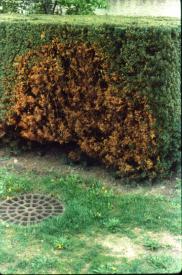

Scorch due to heat rising from storm drain in winter.
|
|
| Severity: | 3-5 out of 5 |
| Frequency: | 3 out of 5 |
| Symptoms: | Leaves are usually the first to die, followed by buds and then the smaller twigs. Diseases can help magnify or increase susceptibility to winter kill. Cankers kill the sapwood tissue, thus reducing or even cutting off moisture to tissue further out on the plant. Winter-kill also makes plants more prone to infectious diseases and insect problems. On evergreens, plants being grown in extremely windy locations are also more prone to winter dehydration. If the dehydration is severe, not only will the foliage die but some of the smaller twigs too. As the dehydration worsens, more and more of the plant is killed untill the entire plant dies. If only the overwinteringfoliage is killed, the plant should leaf out again in the spring. If the woody tissue is dehydrated to the point of death, then the plant needs to be replaced. |
| Cycle: | May be caused by very low temperatures as well as drought stress. With excessively low temperatures, the moisture in the cells freezes (due to chemical compounds in plants, moisture freezes at various degrees below freezing). With drought stress there is a limited amount of moisture in the plant cells. |
| Management: | Plant the right plant for growing site. Plant the plant correctly. Make sure the soil is adequately watered just before ground freezes. In areas where soil does not freeze, water properly through the winter as needed. For windy sites, provide a wind break or spray plants with an anti-desication material. |
| Associated shrubs: | |